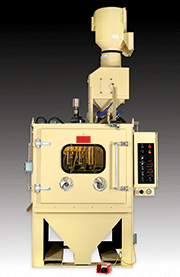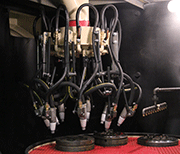E-Archive
Cover Page
in Vol. 17 - July Issue - Year 2016
Standardized And Modular Designs - Features And Benefits

Fig 1: Typical vacuum reclaim system for an Airblast Machine

Fig 2: Empire ProFinish Manual Blast Cabinets have been the modular base for automated products


Fig 3: ProFinish 6060 Platform used to develop a Rotary Head Machine of the same size

Fig 4: Empire ProBot derived from the ProFormer range of blast cabinets
Introduction
At a fundamental level, blast cleaning and shot peening equipment follow similar design principles. The difference is that peening equipment is built with enhanced controls, checks and measures with the purpose of conforming to peening specifications. Standardization of machine design helps in many ways. It assures a uniform process throughout the organization, and through different geographical locations of the same organization. Standardization, when coupled with the modularization of design, could lead to easy adaptation of existing, successful designs and scaling them up to equipment with greater functionality. One such example is the Empire ProFinish line of cabinets, which will be discussed for their evolution into modified cabinets, semi- and fully automated machines leading all the way up to robotics.
In order to fully understand and appreciate the features and benefits of this concept, a logical step will be to understand the critical areas of a blast machine and the impact that their design has on the final product.
Design fundamentals of a blast machine
A blast machine is typically defined by the following sub-systems:
• Blast Enclosure (also referred to as the blast cabinet or blast compartment)
• Media Reclaim and Recovery system
• Blast system (such as nozzles, blast wheels and related accessories; robots, nozzle carriages and related accessories)
• Ventilation and Dust Collection
• Work handling arrangement
• Controls
Blast enclosures can be specific to the product being processed. Therefore, they may require greater engineering time and effort than other aspects of the machine. This is also the reason for applying the modularity concept to this part of the equipment. In order to focus on the topic at hand, this discussion will be restricted to airblast cleaning and peening equipment only.
Media Reclaim and Recovery systems could be vacuum style or mechanical, based on the type and size of media being used. Vacuum recovery systems are classified in terms of their capacity, which varies with the amount of abrasive being recovered (after being discharged from the blast nozzle).
Blast systems or media propulsion systems could be either suction or pressure style. Though base components such as nozzles and hoses vary only by their sizes and materials, other accessories including nozzle manipulators, robots etc. are customized to suit the application.
Style of filters such as cartridges, bag houses etc. will be the differentiating factor, without any change in the standard dust collector design. Handling dust with a propensity for explosion poses its own challenges in terms of design.
Work handling arrangements are part-specific and are usually determined in conjunction with end-user preferences. They could be a standard length of roller conveyor, a rotary table, belt conveyor etc.
Controls are standardized based on the quantity of electrical feeders and nature of the process. Unless the reference is to sophisticated shot peening machines, most manufacturers design their controls in their established routines.
A more detailed review, based on the Empire ProFinish line and its modularity follows.
Modularity as defined by Empire ProFinish Cabinets
Some of the most successful product lines are those that have been endorsed by end users over the years. The basis of endorsement is almost always their functionality, aesthetics, serviceability and very seldom price-based. Such a value-based endorsement can be seen with the ProFinish cabinet line. Therefore, this line is chosen for discussion in order to demonstrate the evolution of a product line through modular and standardized design principles.
Cabinet size variations for this line have been developed over the years, with ProFinish 2636 (26" wide x 36" deep) as the smallest and 7272 (72" wide x 72" deep) the largest in cabinet size. The cabinets, through all the size variations within this range, adopt common and acclaimed design principles such as:
Bolt-secured glove rings in manual versions of the cabinet, assuring a tight seal, to expedite quick glove changeover without the need for tools, and complete with arm rests for improved operator comfort and performance.
High-intensity, manually tilted floodlights to provide adequate illumination for accurate streaming of blast media, dual-panel doors to prevent media spillage when opening, reduced source noise, and complete with OSHA-compliant Safety Door Switch. Cabinet sizes within this range were a result of the market demand for such sizes (3648, 4848, and 6060). Also, cabinets are combined to increase their length in order to process longer parts.
The standard media reclaim system for this family of cabinets is vacuum style. Reclaimer capacities start from 400 CFM, and extend all the way up to 1,200 CFM. Ventilation systems for ProFinish cabinets have the same capacity as the reclaimers. Media reclaim systems have traditionally and functionally been the most redeeming design feature with the ProFinish range. The reclaimers are tunable to control the recovery of fine, medium or coarse abrasive while removing unwanted particles, resulting in reduced media costs and consistent, high-quality finish results. Reclaimers are also factory-fitted with a variety of wear lining options such as Urethane and Ultrawear for long service life.
ProFinish cabinets are manufactured with either suction or pressure style media propulsion systems. The design also offers a kit to convert from one to the other if application changes demand that as a future requirement.
Work handling systems start with a small 18" diameter manually operated table up to 48" powered and rolling versions. A variety of permutations and combinations, without limiting their function, makes this a versatile product. This background helped establish the next line of ProFinish Modified, as determined by the market need.
Modularity of design was established with exactly the same cabinet sizes, reclaimer and ventilation system capacities. Commonality of design helped keep design and manufacturing costs in check. However, end-user requirements brought about the need for additional features including: special work handling such as a roof slot, pass-through vestibules, inter-connected cabinets etc. In some cases, the manual blasting function was substituted by an automated nozzle holding and transporting arrangement such as a carriage (and fast-forwarding to the future) or even a robot. It is important to note that, the modular design allowed for the continued use of standard sizes and capacities for the enclosure, reclaim and ventilation systems for all the ProFinish Modified Cabinets. The Modified line was further stretched to catalog-friendly products that quickly got established as standard machines. Examples of these included the Cell Machine (CMM), Inline Blast System (ILS) and Basket style machines (BB). All such machines feature automatic nozzle movement and carry multiple nozzles. Once again, critical, pre-designed modules of cabinets, reclaim, ventilation and blast systems helped accelerate the 'time to market' for this product line.
Leap into Robotics with the ProFinish Platform
In all versions of the basic ProFinish cabinet, whether it be manual blast, modified or automated such as the inline machine, the familiar sights would be the cabinet size with its distinct design features, reclaimer and the dust collector. The opportunity then presented itself to extend this successful design into robotics. The RBT-36 and RBT-60 were derived from ProFinish 3648 and 6060 cabinets respectively. The only aspect that changed was the manner in which the nozzle was presented to the part. The operator that was manipulating the nozzle in the primary version of this cabinet was supplanted by a robot. Some of the noteworthy additions that came along with the robotic systems include:
• Process control package for shot peening
• Servo-driven tables for accurate part positioning
• Vision system to confirm part location on the servo-table
• Computer-assisted controls
A simple concept on standardizing cabinets in the 1950s and 60s led to modular thinking and has now resulted in contributing to processing sophisticated aircraft components and medical implants using robots - all in the same cabinet module!
This concept carries great benefit to both the customer and manufacturer, in this case Empire.
Note: Picture in the cover shows an Empire ProBot which is derived from the ProFormer series of cabinets. The design allows for a single enclosure to house the cabinet, reclaimer, dust collector and robot controller allowing for ease of installation and relocation, if required in the future.
For the manufacturer (Empire)
• Reduced engineering costs, easy scalability of design and a wide range of components available to mix and match when the application demands it
• Reduced lead times and the opportunity to stock inventory of standard modules (for example, reclaimers, dust collectors, cabinet accessories etc).
• Opportunity to focus on innovation in areas of design that carry value to the end-user (such as part and work handling, fixturing, controls and training)
For the end-user
• With companies like Empire that have been in business for 70+ years, their customer base, over the years, has purchased multiple machines. Most of those are still functional and the users have grown comfortable with the machine operation, maintenance etc. For such customers, modularization is a welcome concept since the attraction of automating a manual process is always high.
• Such end users now have the choice of a proven product since the core of the design is relatively unchanged
• Cost advantages and commonality of spares with existing cabinets
• Change in part style leading to a different work handling or nozzle arrangement is easily accommodated with minor retrofits
• The option of carrying out the retrofit themselves (with Empire supplied components) due to their familiarity
Summary
This discussion started with the Empire ProFinish line, a product originating from its manual blasting roots. As in this case, it certainly helped to have a well-engineered range of cabinets. Taking a step further, the concept of modularity can be extended to controls, sound insulation panels, mechanical reclaim systems and dual work handling arrangements. The next generation of modularity may contain more than just equipment. It could be extended to training, service and maintenance programs. It could extend into different controls system packages that would be more intuitive than the current availability. The future for modular designs shows a lot of promise and benefits for suppliers and customers alike.
For Information:
Empire Abrasive Equipment
2101 W. Cabot Blvd.
Langhorne, PA 19047-1893, USA
Tel. +1.215.752 8800
Fax +1.215.752 9373
E-mail: airblast@empire-airblast.com
www.empire-airblast.com




























